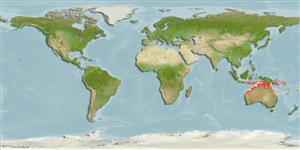Common names from other countries
>
Carangiformes (Jacks) >
Carangidae (Jacks and pompanos) > Caranginae
Etymology: Caranx: French, carangue, the name of a Caribbean fish; 1836 (Ref. 45335).
More on authors: Alleyne & Macleay.
Environment: milieu / climate zone / depth range / distribution range
Ecologie
marien; brak water rifbewoner; diepte 7 - 63 m. Tropical; 7°S - 23°S
Southwest Pacific: Arafura Sea (Ref. 9819), northern Australia, from the Timor Sea in the west (Ref. 6905) to the Gulf of Papua in the north (Ref. 6906) and on the eastern coast of Australia as far south as Gladstone (Ref. 6907).
Lengte bij maturiteit / Grootte / Gewicht / Leeftijd
Maturity: Lm ?, range 11 - ? cm
Max length : 66.0 cm TL mannelijk / geslacht onbekend; (Ref. 2334)
Adults are common in prawn trawling grounds and are most abundant closer to the coast. They feed predominantly on benthic prey consisting mainly of crustaceans and teleosts (Ref. 6908). They exhibit diel vertical migration, possibly following the movement of crustaceans along the water column. Continuous spawning during the year (Ref. 6904). Juveniles are often encountered in estuaries. Caught mainly on hook-and-line and by spearing; also with gill nets and other artisanal gear. This species is an excellent sports fish (Ref. 9894).
Randall, J.E., G.R. Allen and R.C. Steene, 1990. Fishes of the Great Barrier Reef and Coral Sea. University of Hawaii Press, Honolulu, Hawaii. 506 p. (Ref. 2334)
Status op de Rode Lijst van het IUCN (Ref. 130435)
CITES (Ref. 128078)
Not Evaluated
Gevaar voor de mens
Harmless
Gebruik door de mens
Visserij: van minder commercieel belang; sportvis: ja
Tools
Speciale rapporten
Download XML
Internetbronnen
Estimates based on models
Preferred temperature (Ref.
115969): 26.2 - 28.6, mean 27.7 (based on 326 cells).
Fylogenetische diversiteitsindex (Ref.
82804): PD
50 = 0.5000 [Uniqueness, from 0.5 = low to 2.0 = high].
Bayesian length-weight: a=0.02455 (0.01365 - 0.04414), b=2.92 (2.76 - 3.08), in cm Total Length, based on LWR estimates for this species & (Sub)family-body (Ref.
93245).
Trofisch niveau (Ref.
69278): 3.8 ±0.0 se; based on diet studies.
Weerstandsvermogen (Ref.
120179): Gemiddeld, minimale populatieverdubbelingstijd 1,4-4,4 jaar (K=0.30; Fec: >8,000).
Fishing Vulnerability (Ref.
59153): Moderate vulnerability (36 of 100).
